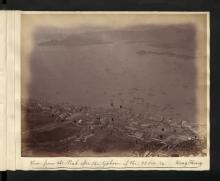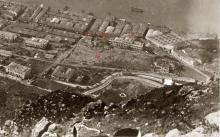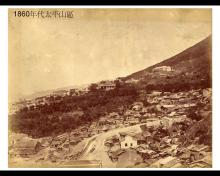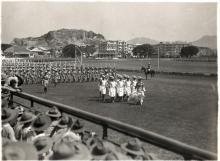Get Gwulo's books
Directory
Click on your area of interest to choose from over 30,000 pages about old Hong Kong:
- Images & photos
- View - View galleries - View new - Create - Forum topics
- View - Create - Places & buildings
- View map - View new - Create - Streets
- View map - View new - Create - People
- View - View new - Create - Organisations
- View all - View new - Create - Diaries & memoirs
- View - View new - Create diary - Create page - Events
- View - View new - Create - Jurors lists
- View - Type a page
Or choose a popular article:
User login
Timeline
A timeline of Places at this site.
This:
- Berlin Mission / Bethesda Orphanage [1861-????]
Newer:





Comments
Berlin Mission
The "Berlin Mission" on the 1901 map is the site of the "Findelheim Bethesda" - "Orphanage Bethesda". The foundation stone for the building was laid in 1861. The orphanage sheltered female babies and girls that were "thrown away" in southern China. Although strictly banned by imperial chinese law "throwing away" girls was a sad habit for poverty stricken southern-chinese parents. Girls were left to die in the fields or the streets or were handed over as wasted girls to missionaries. Disabilities of all kinds were another reason to leave a female child behind. To foster these little girls the "Berliner Frauen Missionverein für China", the "Berlin Ladies Missionary Society" was founded in Berlin in 1850 as an initiative by Karl Gützlaff, Charles Gutzlaff.
The orphanage developed to be a renowned school for disadvantaged Chinese girls. The girls excelled in the annual Bellilios Exams and took a career from "left to die in the streets" to a western and modern education. The aim of the Berlin Missionary Ladies was to raise "good Christian housewifes" and to marry them off to to good Christian Chinese husbands to spread the gospel into China. Some of them became nurses, teachers or even doctors. After leaving the orphange they always kept a close relation to their orphange.
The Findelhaus Bethesda was closed down in WWI as enemy property. More than 1000 girls went through this renowned educational institution until then.
I wonder, if any family in Hong Kong or Southern China can trace back it´s roots to that home. It had a great influence in Hong Kong and Southern China. My wife, for example, met by chance a lady in Stuttgart, Germany, whose ancestor had been a teacher at the Orphange Bethesda. So, if there are there any offsprings of the "Findelheim Bethesda", please contact through gwulo.com.
USC image collection
Pupils of the blind school in Hong Kong (China)
Annotation translation: [On the reverse of the card there stands printed:]
"The fate of a chinese girl is sad. But the fate of her blind sister is terrible. Many blind girls are either poisoned or buried alive by their relatives or they are sold to wicked women who subject them to a life of shame. The missions have taken up this problem and founded asylums for the blind where they are cared for and taught braille, knitting, straw-weaving and other occupations. The home for the blind in Hong Kong, run by the Berlin Womens' Association, is one such asylum. Many of these unhappy creatures have found a true home there - but also a Father with a heart for them.
[Edit: links to Basel Mission photos at USC removed. See http://gwulo.com/node/6029]
Bethesda Orphanage
Christoph & Annelise, thanks for the extra information.
I found the Fanling Babies Home website. They write:
Our mission is to discover and network with individuals connected to Hong Kong orphanages and children homes such as, Fanling Babies Home, Pine Hill Babies Home, Shatin Babies Home, Precious Blood Babies Home in the New Territories, Evangel Children's Home, Ling Yuet Sin Infants Home, St. Paul's Creche, Yuen Long Children's Home, Eric Bruce Hammond M. Orphanage, St. Christopher's Home and Po Leung Kuk.
It looks as though they're focused on orphans from post-WW2, but they may also get inquiries from families of older orphans such as those at the Bethesda Orphanage.
While I was in the UK this summer, I paid a visit to the Foundling Museum in London for the first time. My great-grandfather had been accepted there as a foundling, and so it was very interesting to read about its history. Although the children who were accepted were considered the lucky ones, it sounded a very hard life to me.
Regards, David
Bethesda Orphanage & Missionaries
Annelise & David, thank you for your replies.
David, you are absolutely right: life was hard for the saved girls. Besides school they had to run the household of the orphanage. Only on rare occasions they could leave the premises. Their Chinese non-Christian background was talked down, although the Missionaries appreciated and admired the Chinese culture. Raised in the modern ambience of Hong Kong they later found themselves living in rural Southern China. Some hence complained that they had not been taught anything to handle the life of a farmer´s wife. The nurses, teachers and doctors were better off. On the other hand these girls were far more self-reliant than the average Chinese girl and well educated and better prepared for the future China was about to face.
Annelise, thanks for the pictures. They are from the USC collection of the Basel Mission, not Berlin. I love to page through them. In times of turmoil in China the missionaries of all the various societies fled to Hong Kong for shelter. And it is difficult to get them in order. Here´s an overview of the early Protestant German-speaking missionary societies of the early days:
The first missionaries with German-speaking background came in 1847 from the Basel Mission and the Rheinische Mission (Barmer Mission) – they developed to today´s Tsung Tsin Mission, and Chinese Rhenish Church.
In 1850 the first and only missionary of the Chinese Foundation, Chinesische Stiftung, based in Kassel stepped ashore. He felt very desolate and got engaged with a Chinese non-Christian lady. (Western women were a rare species in Hong Kong in those times.) He was ordered back in 1853 and fired. The Chinese Foundation ceased to exist shortly afterwards.
In 1853 a missionary married couple arrived. He had been sent by the Berliner Hauptverein für China, Berlin Missionary Main-Association for China, his wife by the Berliner Frauen Missionsverein für China, Berlin Ladies Missionary Association. She was the one, who started the work with the orphaned girls which later became the Berlin Foundling Home Bethesda, the “Berlin Mission” Building on the 1901 map located in High Street.
1896 the Hildesheimer Blindenmission, today´s Ebenezer School & Home for the visually Impaired, commenced its work. (@gwulo: Home for the Blind)
The Berlin Foundling House
The Berlin Foundling House, situated in High Street, off Bonham Road, was founded by the Berlin Ladies Mission in the year 1861. The first lady missionary from this society arrived in Hongkong in 1850 and resided for a time at Morrison Hill, the centre of Educational and Mission Work at that period. As its name implies, the Mission had in view the saving of those female children which, by long established custom, the native mothers have been brought up to discard, throw away, abandon, leave on the road side to die. In Chinese family life the female off-spring is thought little of, and should she be allowed to live, has, through her years of girlhood, without the slightest effort to educate her, to act as a general drudge for the rest of the family. This is more particularly when she is not considered sufficiently good-looking for the cultivation of small feet.
On a child entering the Foundling House it becomes the property, so to speak, of the Mission, who educate and train her to a useful life, and in a great many cases, see her comfortably settled as the wife of an educated native preacher of one of the many societies doing Mission work in the neighbourhood. The institution is supported by the generosity of patrons at home and in the Colony.
Source: The Tourist's Guide to Hong Kong, with short trips to the Mainland of China (1897) by HURLEY, R. C.
Berlin Foundling Chapel (cross reference)
I've put a query about the Berlin Foundling Chapel under "Louis Kirchmann". Kirchmann held the wedding of his Eurasian daughter, Carolina, there in 1888 and I'm wondering if the chapel was within the Berlin Foundling Mission and whether it was usual for the daughters of German fathers and Chinese mothers to be married there.
Jill
Carl Smith on the German Congregation
I've now found the relevant article on the German Congregation by Carl Smith in RASHKB Vol 15 as follows:
"The Hong Kong Blue Books under 'Ecclesiastical Returns' lists as a place of worship for Europeans the chapel of the Berlin Mission House from 1871 through 1919, though services were probably not held during the war years (...) The congregation originally met in the chapel within the Berlin Foundling House, but in 1881 they occupied a small chapel built on the same premises. (...) For some reason the services were moved in 1902 to the Church Hall of Union Church. Here the group met until 1904 as the "Deutsche Kirchen and Schulegemeinde." It then moved back to Bethesda Chapel, where services were held until the congregation was broken up by the outbreak of the War in 1914."
I wonder if the Berlin
I wonder if the Berlin Mission chapel was rebuilt in 1902. On the Chinese Rhenish Church, Bonham Road page here, there is a picture of a bell that is on display dated 1903 that likely came from the Berlin Mission House chapel
1914 - 1919: The effects of WW1
1914
The declaration of war meant that German residents in Hong Kong were considered enemy aliens. Most of the individuals were interned, and their businesses confiscated. (See "Alien Enemies (Winding up) Ordinance" in the Legco minutes of 27 Oct 1914.)
The Berlin Foundling Home was clearly a German-run organisation, but it couldn't simply be locked up like a warehouse, as the young girls there still needed to be looked after. It continued operation, under the oversight of the Church Missionary Society (CMS).
"The Government has allowed three German ladies to remain in each home and the writer was asked to take general oversight." From a report by Canon Banister sent to the Church Missionary Society in 1914, quoted in The German Speaking Community in Hong Kong 1846-1918. by Carl T Smith.
1918
The home was still in operation, as it was mentioned in the Legco meeting on 17th October 1918:
H.E. THE OFFICER ADMINISTERING THE GOVERNMENT― [...] The German charitable institutions are the Hildesheim Mission for the Blind and the Berlin Foundling Home. They are still receiving this grant of $15,000 in order to enable those in charge to carry on.
HON. MR. HOLYOAK ― Are the German Superintendents still in charge?
H.E. THE OFFICER ADMINISTERING THE GOVERNMENT―No. The German ladies still remain there and the children and they will have to remain there, I think.
1919
In early 1919 the CMS agreed to vacate the site of the Berlin Foundling House. (See p.171 of The First World War as a Turning Point / Wendezeit Weltkrieg.)
The site was vacated, as on 4 Sep 1919, Legco approved funds to convert the site into police quarters:
Married Police Quarters
The Officer Administering the Government recommended the Council to vote a sum of three thousand, two hundred and fifty dollars ($3,250) in aid of the vote Public Works, Extraordinary, Hongkong, Buildings, Conversion of Berlin Mission Foundling House into Married Police Quarters.
THE CHAIRMAN―As hon. members know, the children from this house have been taken care of by British Missionary Societies. The building is not at present required, and is being
used temporarily as quarters.
HON. MR. ALABASTER―I hope the title will not be retained for the Police married
quarters.
THE COLONIAL SECRETARY―No.
The vote was agreed to
The Public Works Department Annual report for 1919 confirms that one of the buildings of the Foundling House was converted into married quarters for the Police:
139. Berlin Mission Foundling House, Bonham Road.— Conversion into quarters for Married Police.—Alterations were carried out in the large building which was erected during 1914-15 in order to adapt same for occupation as Married Police Quarters.
Two quarters, one of four rooms and one of two rooms, are provided on the ground floor and two quarters of three rooms each on the first floor. Servants’ quarters are provided on a lower floor which, owing to the configuration of the ground, extends over a portion of the building.
1919 Estimates, —
1919 Expenditure, $2,208.62